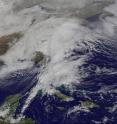NASA eyes powerful winter storm spreading into mid-Atlantic
Related images
(click to enlarge)
The winter storm that caused damage during the night along the Gulf Coast has deepened and has started to spread heavy rain, freezing rain, sleet and snow northward into the Mid-Atlantic region. NASA's GPM and NOAA's GOES satellites are providing data on rainfall, cloud heights, extent and movement of the storm. The National Weather Service (NWS) Weather Prediction Center in College Park, Maryland said "An area of low pressure centered over the southeastern U.S. will continue developing into a major winter storm which will impact a large portion of the East Coast from the southern Appalachians through the Mid-Atlantic States from Friday into the weekend. Snowfall totals may exceed 2 feet in portions of these areas, including the Baltimore and Washington D.C. metropolitan areas."
The Global Precipitation Measurement or GPM mission core satellite gathered precipitation data on the increasingly dangerous storm on January 22, 2016 at 1329 UTC (8:29 a.m. EST). A precipitation analysis was created using data collected by GPM's Microwave Imager (GMI) and Dual-frequency Precipitation Radar (DPR) instruments. GPM's DPR saw precipitation falling at a rate of over 64 mm (2.5 inches) per hour in storms over northern Alabama.
At NASA's Goddard Space Flight Center in Greenbelt, Maryland, radar data from GPM's DPR (Ku Band) were used to show the vertical structure of storm tops. Some of the storm tops were near 7 kilometers (4.3 miles) high along the Appalachians in eastern Tennessee and Kentucky. Higher storm cloud tops are indications that storms are likely stronger. At 3:46 a.m. EST on Jan. 22, the National Weather Service said "Areas of heavy snow are expected to develop in western Tennessee, Kentucky and in the southern Appalachians, and expand into central Appalachians and mid-Atlantic while increasing snowfall intensity."
An animation of infrared and visible imagery from NOAA's GOES-East satellite from Jan. 20 to 22 was created to show the movement of the system through the central U.S. into the Mid-Atlantic region. A visible image from NOAA's GOES-East satellite at 1830 UTC (1:30 p.m. EST) showed clouds associated with the winter storm stretching from Arkansas to the northeastern U.S. coast. The animation and images were created by the NASA/NOAA GOES Project at NASA Goddard.
NWS said "A strong low over the Atlantic waters will become a dominant force in setting up very gusty winds in the Mid-Atlantic to Long Island, with storm surge flooding possible."
The impacts from the storm stretch from the Ozark Mountains to the Mid-Atlantic. On Jan. 22, the NWS said heavy snowfall and increasingly strong winds through Saturday are predicted to cause dangerous blizzard conditions in Washington, D.C. where blizzard warnings were in effect. To the south, a quarter to half inch of ice accumulations across parts of the interior Carolinas outside the mountains - with lighter amounts expected in Kentucky and over the much of the central/eastern Carolinas. Severe weather is also possible across eastern Gulf coasts and Florida.
That winter storm is not the only big weather maker in the United States as another low pressure area was affecting the Pacific Northwest. On Jan. 22, heavy rainfall is expected in lower elevations of northwestern California and southwestern Oregon with heavy snow in higher elevations of Sierras and Washington Cascade mountain range.
For updated forecasts, visit NOAA's NWS website: http://www.weather.gov
Source: NASA/Goddard Space Flight Center
Articles on the same topic
- NASA provides a look at post-blizzard snowfall and windsMon, 25 Jan 2016, 23:21:55 UTC
- NASA sees winter storm slamming eastern United StatesMon, 25 Jan 2016, 16:43:39 UTC
- NASA sees dawn and records breaking as major winter storm departsMon, 25 Jan 2016, 16:43:19 UTC
- NASA sees gulf coast severe weather from developing winter stormFri, 22 Jan 2016, 16:26:41 UTC
Other sources
- NASA Provides a Look at Post-Blizzard Snowfall and Windsfrom Newswise - ScinewsWed, 27 Jan 2016, 19:41:05 UTC
- NASA provides a look at post-blizzard snowfall and windsfrom PhysorgTue, 26 Jan 2016, 8:40:39 UTC
- NASA sees dawn and records breaking as major winter storm departsfrom PhysorgMon, 25 Jan 2016, 17:03:45 UTC
- NASA sees winter storm slamming eastern United Statesfrom PhysorgMon, 25 Jan 2016, 16:14:11 UTC
- Winter Storm Views from Space: See the Latest Satellite Imagesfrom Live ScienceSat, 23 Jan 2016, 0:21:02 UTC
- NASA eyes powerful winter storm spreading into mid-Atlanticfrom PhysorgFri, 22 Jan 2016, 23:43:35 UTC
- Winter Storm Views from Space: See the Latest Satellite Imagesfrom Space.comFri, 22 Jan 2016, 22:02:15 UTC
- NASA sees gulf coast severe weather from developing winter stormfrom PhysorgFri, 22 Jan 2016, 16:20:01 UTC
- East Coast energy under threat from winter stormfrom UPIFri, 22 Jan 2016, 14:51:01 UTC
- NASA image: Major winter storm headed for eastern U.S.from PhysorgFri, 22 Jan 2016, 11:00:39 UTC
- NASA Sees Massive Winter Storm Moving Eastfrom Space.comThu, 21 Jan 2016, 23:50:37 UTC
- NASA satellites film major snowstorm approaching East Coastfrom UPIThu, 21 Jan 2016, 20:04:09 UTC
- NASA Sees Massive Winter Storm Moving Eastfrom Live ScienceThu, 21 Jan 2016, 19:36:00 UTC
- SnOMG! Developing Blizzard Seen From Space | Time-Lapse Videofrom Space.comThu, 21 Jan 2016, 16:51:32 UTC
- SnOMG! Developing Blizzard Seen From Space | Time-Lapse Videofrom Live ScienceThu, 21 Jan 2016, 16:38:20 UTC

